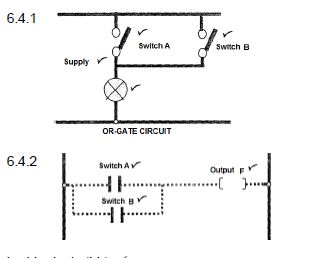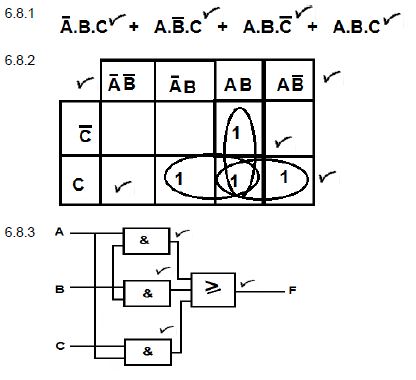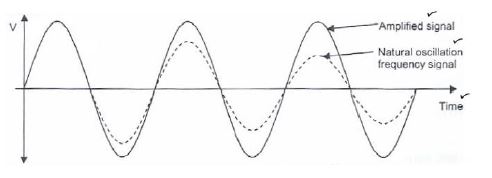ELECTRICAL TECHNOLOGY GRADE 12 MEMORANDUM - NSC PAST PAPERS AND MEMOS SEPTEMBER 2017
Share via Whatsapp Join our WhatsApp Group Join our Telegram GroupELECTRICAL TECHNOLOGY
GRADE 12
NSC PAST PAPERS AND MEMOS
SEPTEMBER 2017
MEMORANDUM
QUESTION 1: OCCUPATIONAL HEALTH AND SAFETY
1.1 No person may enter or remain in a workplace under the influence of drugs as he may place himself ✔ and other persons in danger while operating machinery. ✔ (2)
1.2
- Earth-leakage system ✔
- Overload circuit breakers ✔
- No-volt coil prevents automatic restarting after power interruption.
- Fuses
- Emergency stop switch
(ANY TWO) (2)
1.3 If Aids is not brought under control:
- it can affect productivity in that employees with skills may become ill or die ✔
- person may not function well, may take time off work, ✔
- Colleagues may be unwilling to work with a person having HIV due to the stigma associated with HIV.
(ANY TWO RELEVANT ANSWERS) (2)
1.4
- Safety is the responsibility of any person who enters or works in an electrical technology workshop. ✔
- Each person has a responsibility to himself and others around him. ✔
- It only takes one person to ignore safety procedures to cause serious problems for all in the electrical technology workshop. ✔
(ANY SOUND MOTIVATED RESPONSE MUST BE CONSIDERED) (3)
1.5
- Wet floors ✔
- Wet work areas
- Bare conductors
(ANY OTHER RELEVANT ANSWERS) (1)
[10]
QUESTION 2: THREE-PHASE AC GENERATION
2.1
2.1.1
| P = √3VLILcosθ ✔ = √3 × 380 × 20,78cos25º ✔ =12,40 kW ✔ | ButIL = √3IPH = √3 × 12 = 20,78 A |
OR | P = 3VPHIPHcosθ ✔ = 3.380.12.cos25º ✔ =12,40 kW ✔ |
(3)
2.1.2
| S = √3VLIL ✔ = √3 × 380 × 20,78 ✔ = 13,68 kVA ✔ | OR | S = P ✔ cos θ = 12,40 ✔ cos 25 =13,68kVA ✔ |
(3)
2.2
| VL = √3PH ✔ = √3 × 220 ✔ = 381,05 V ✔ |
(3)
2.3
- For high power generation the three-phase system is functional and efficient. ✔
- The voltages between all phases (i.e. line voltages) are the same
- The direction of rotation of three-phase machines can be easily changed
- Transmission and distribution are fairly simple
(ANY ONE) (1)
2.4 A generator has a lagging power factor ✔ as it consists of coils which are inductive. ✔ Current through an inductor connected to an AC supply lags the applied voltage. ✔ (3)
2.5 The function of a kWh meter is to measure the amount of power consumed by a consumer over a period of time (energy). ✔ (1)
2.6 120 degrees (1)
2.7 (4)
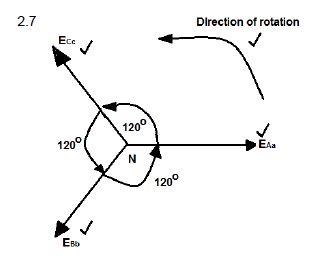 |
2.8 Effective value or rms value ✔ (1)
[20]
QUESTION 3: THREE-PHASE TRANSFORMERS
3.1
- Copper losses ✔ losses due to the resistance of the copper wires used ✔
- Stray losses ✔ occurs when some of the magnetic field does not cut the secondary winding ✔
- Iron losses ✔ heat losses due to hysteresis of the core ✔
- Dielectric losses ✔ occurs when insulation of windings is damaged, causing leakage currents ✔ (4)
3.2
3.2.1
- S = P ✔
cos θ
= 10000
0,8
= 12, 5kW ✔ (3)
3.2.2
- IL(S) = P ✔
√3L(S) cosθ
= 10000 ✔
√3 × 400 × 0,8
= 18,04A ✔ (3)
3.2.3
- IPh(S) = IL(S) ✔
= 18,04 A ✔ (2)
3.3 To create a three-phase four-wire system ✔ so that a transformer can supply both single-phase ✔ and three-phase. (To distribute power to both domestic and industrial installations.) ✔ (3)
3.4
- Losses and current flow in transformers causes heat build-up ✔
- Overloading ✔
- Poor Cooling ✔
- Lack of Ventilation
- Poor Connections / Hot connections
- Excessive vibration due to poor mechanical construction
(ANY RELEVANT ANSWERS) (3)
3.5 The primary phase current will also be doubled ✔ as it is directly proportional to the load. ✔ (2)
[20]
QUESTION 4: THREE-PHASE MOTORS AND STARTERS
4.1 The purpose of using a starter to start a three-phase motor is to safely control the motor, ✔ protect electrical equipment and the user of the motor. ✔ (2)
4.2
- Stator ✔
- Rotor ✔
- End plates ✔
- Fan
- Terminal box
- Bearings
(ANY THREE) (3)
4.3 To reduce the voltage at start-up. ✔ This in turn reduces the starting current.▪✔ Reduced starting current leads to fewer nuisance tripping problems at start or to less heat build-up and decreases the chance of burn-out of the motor. ✔ (3)
4.4
4.4.1
- IL = P
√3 × VLcosθ✔
= 15000
√3 × 380 × 0,9 ✔
= 25,32 A ✔ (3)
4.4.2
- Papp = P ✔
cosθ
= 15000
0,9 ✔
= 25
√3
= 16,67 kVA ✔ (3)
4.4.3
- IL = √3 × IPH✔
IPH = IL
√3
= 25
√3 ✔
= 14,43A ✔ (3)
4.5
4.5.1
- S = P
cos θ
=90 000
0,85
= 105,88 kVA (2)
4.5.2
- IL= P
√3VL cos θ
= 90 000
√3 x 400 x 0,85
= 152,83 A (3)
4.6 By reversing the connections of any two of the three supply lines to the stator. ✔ (1)
4.7 To protect electrical equipment from damage ✔ during faulty operating conditions and protecting the operator of the equipment. ✔ (2)
4.8 The motor will keep on operating, but to maintain the same output power ✔ the current on the other two phases will increase. ✔ If the protection is set correctly, it will engage, protecting the motor from permanent damage. ✔ (CONSIDER RELEVANT MOTIVATED ANSWERS) (3)
4.9
4.9.1 The function of a star-delta starter is to reduce the starting current of a motor at start as a motor draws 3 to 4 times full-load current at start.✔ (1)
4.9.2 The motor is connected in star at start. ✔ This reduces the voltage across the motor windings which in turn reduces the current in the windings.✔ Once the starting current has reduced, the motor windings are changed over to delta, restoring full-line voltage across the windings, therefore full current. ✔ (3)
4.10 The overload relay is designed to protect the motor ✔ and motor wiring against current fault conditions. ✔ It will open and cut power to the motor. ✔ (4)
4.11
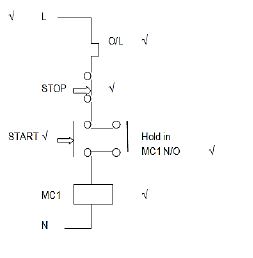 |
(4)
[40]
QUESTION 5: RCL CIRCUITS
5.1
5.1.1
- Z = √R2 + (XL - KC)2
= √5002 + (300 - 250)2
= 502, 49Ω (3)
5.1.2
- cosθ = R ✔
Z
= 500
502, 49 ✔
= 0,995✔ Lagging ✔ (4)
5.2
5.2.1
- R = V2 ✔
P
= 1102
60✔
= 201, 67 Ω ✔ (3)
5.2.2
- I = P
VR ✔
= 60
110 ✔
= 0,55 A ✔ (3)
5.2.3
- Z = V
I ✔
= 220
0,55 ✔
= 400 A ✔ (3)
5.2.4
- XL = √Z2 - R2
2πfL = √Z2 - R2
L = √Z2 - R2
2πf ✔
= √4002 - 201, 672
2.π.50 ✔
= 1,1 H ✔ (4)
[20]
QUESTION 6: LOGIC
6.1 A series of instructions ✔ written in a language ✔ that a PLC can recognise and interpret into an output. ✔ (3)
6.2 Programmable Logic Controller ✔ (1)
6.3
- User interface (On the PLC Unit – Screen & Buttons).✔
- Computer or laptop with interface cable.✔
- Handheld programming device.✔ (3)
6.4
6.5
- Ladder logic (LL). ✔
- Logic block diagram (LBD). ✔
- Function Block Diagram (FBD)
- Structured Text Sequential Flow / Function Chart
(ANY THREE) (3)
6.6  (5)
(5)
6.7 Fewer components such as contactors are subject to wear because less of these items are used. ✔Additionally units have built-in diagnostic functions. ✔ (2)
6.8
[40]
QUESTION 7: AMPLIFIERS
7.1
- Linear amplifiers √
- Pulse amplifiers √
- Buffer circuits Integrating √
- Differentiating
- Summing amplifiers
(ANY THREE) (3)
7.2
- Input draws no current √
- The voltage drop between the input terminals is zero √
- The open-loop voltage gain is infinite √
- Output impedance is zero. Input impedance is infinite
- Frequency Response is infinite
(ANY THREE) (3)
7.3 Means that there is no feedback (neither negative nor positive) √ from the output back to the input. √ The gain of the circuit is at a maximum. √ (3)
7.4
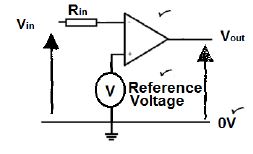
7.5 A portion of the output signal is fed back to the input signal ✔ and is in phase with the input signal (2)
7.6 This will reduce the loading effect on the previous circuit. ✔ In so doing, no current will be drawn ✔ from that circuit. Therefore, the voltage appearing √ at its output terminals ✔ will be passed on to the op amp with little or no loss. (4)
7.7
- Audio oscillators ✔
- Electronic organ ✔
- GPS units ✔ (3)
7.8
7.8.1

7.8.2 Output signal ✔ is fed back to the inverting input ✔ through feedback resistor Rf .✔ (3)
7.8.3 If the resistance of Rf is decreased Vrf will decrease ✔ this is feedback on the inverting input of the op-amp ✔ increasing the overall gain of the circuit. ✔ (3)
7.8.4 Rin allows further control ✔ of the op-amp circuit gain. ✔ Setting Rin at a high value compared to Rf creates a voltage-follower circuit. ✔ (3)
7.9
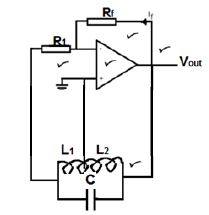
7.10 The output of the comparator will be zero. ✔ This is due to a comparator only amplifying the difference between the input signals. ✔ (2)
7.11 The frequency of the wave form remains unchanged. ✔ (1)
7.12
The electrical signal that the oscillator produces is called the natural oscillation frequency. ✔ Natural oscillation diminishes in amplitude and disappears due to a lack of positive feedback. ✔ (6)
7.13 When an op-amp is utilised between stages it is used as a buffer amplifier to adapt/match the impedance between the stages. ✔✔ (2)
7.14 Any application where a phase shift is not required, ✔ such as: audio amplifiers. ✔ (2)
[50]
TOTAL: 200

